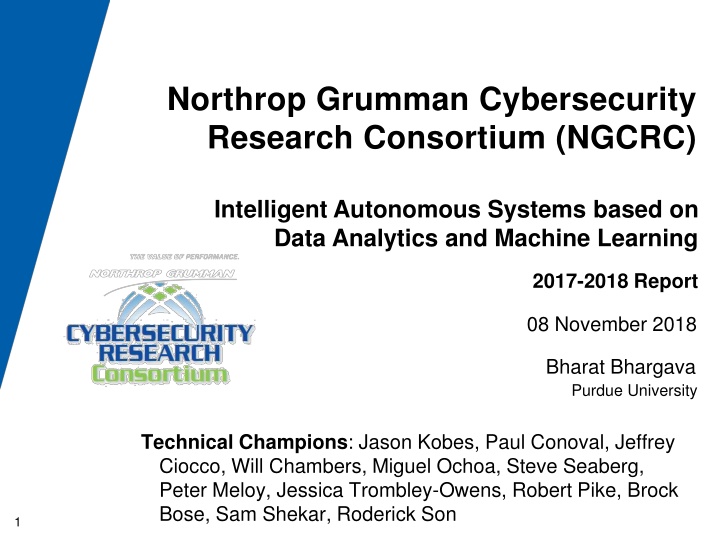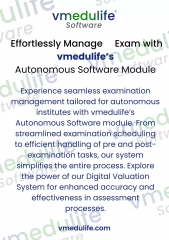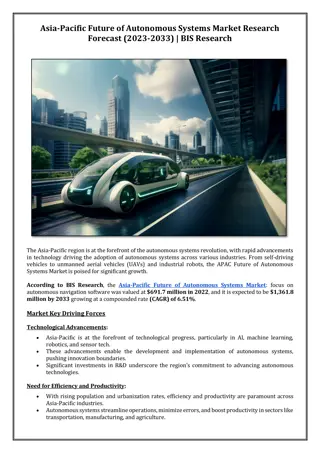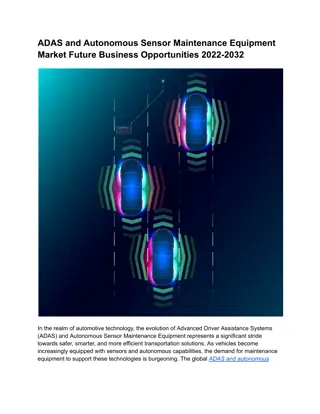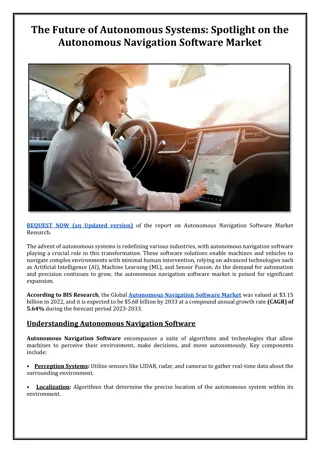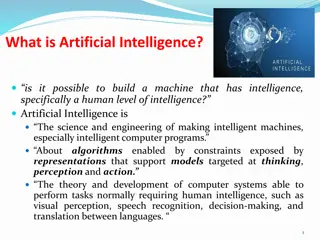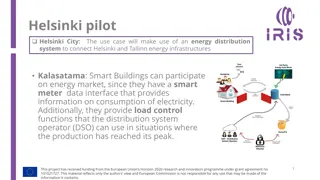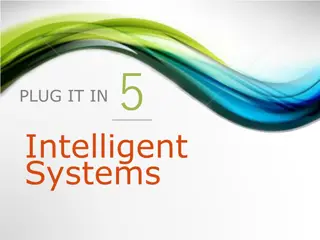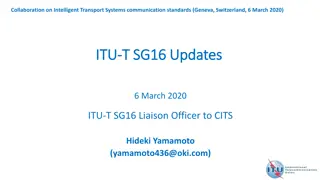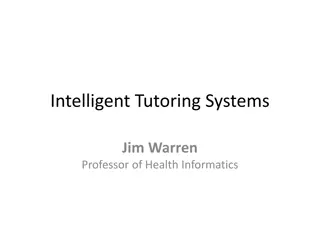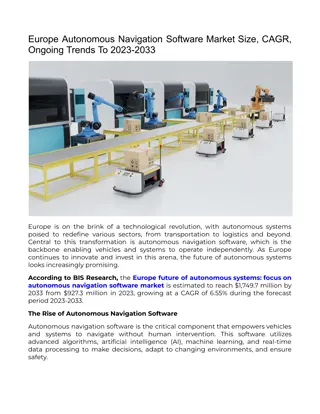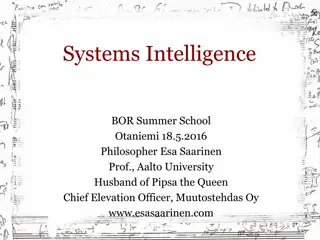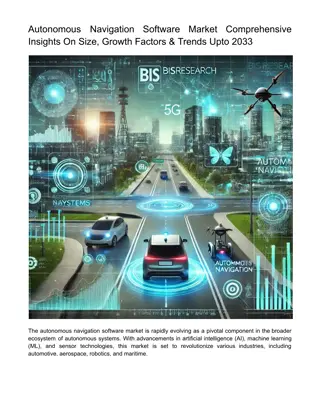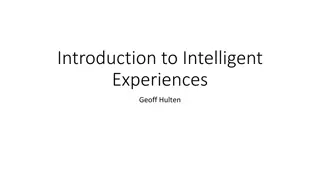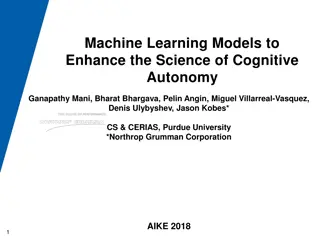Innovative Research on Intelligent Autonomous Systems
Conducted by Northrop Grumman Cybersecurity Research Consortium (NGCRC), this report delves into the development of Intelligent Autonomous Systems (IAS) based on data analytics and machine learning. The research focuses on enhancing cognitive autonomy, knowledge discovery, reflexivity, and trust in autonomous systems through various innovative methodologies and models. Key achievements include the development of lightweight machine learning and deep learning models for system profiling, fuzzy-based clustering for scalable learning, privacy-preserving aggregated data analytics, combinatorial design-based graceful degradations, and blockchain implementation for provenance storage.
Uploaded on Mar 15, 2025 | 1 Views
Download Presentation

Please find below an Image/Link to download the presentation.
The content on the website is provided AS IS for your information and personal use only. It may not be sold, licensed, or shared on other websites without obtaining consent from the author.If you encounter any issues during the download, it is possible that the publisher has removed the file from their server.
You are allowed to download the files provided on this website for personal or commercial use, subject to the condition that they are used lawfully. All files are the property of their respective owners.
The content on the website is provided AS IS for your information and personal use only. It may not be sold, licensed, or shared on other websites without obtaining consent from the author.
E N D
Presentation Transcript
Northrop Grumman Cybersecurity Research Consortium (NGCRC) Intelligent Autonomous Systems based on Data Analytics and Machine Learning 2017-2018 Report 08 November 2018 Bharat Bhargava Purdue University Technical Champions: Jason Kobes, Paul Conoval, Jeffrey Ciocco, Will Chambers, Miguel Ochoa, Steve Seaberg, Peter Meloy, Jessica Trombley-Owens, Robert Pike, Brock Bose, Sam Shekar, Roderick Son 1
Intelligent Autonomous Systems Autonomous Systems should be Able to perform complex tasks without or with limited ongoing connection to humans. Cognitive enough to act without a human s judgment lapses or execution inadequacies. Intelligent Autonomous Systems (IAS) are characterized as highly Cognitive,effective in Knowledge Discovery, Reflexive, and Trusted. The focus of this research was on the smart cyber systems. 2
Comprehensive IAS Architecture Adaptive action Anomaly Detection 3
Accomplished Research Tasks We completed and demonstrated the tasks that advance the major characteristics of autonomous systems: Cognitive Autonomy Developed light-weight ML / deep learning models for system profiling (black/white listing) & anomaly detection. Knowledge Discovery Developed fuzzy-based clustering for scalable learning to discover new knowledge & patterns. Developed privacy-preserving aggregated data analytics. Reflexivity Implemented combinatorial design-based graceful degradations with Bayesian inference. Trust Implemented Blockchain for provenance storage. 4
Publications https://www.cs.purdue.edu/homes/bb/#research https://www.cs.purdue.edu/homes/bb/#colloquia 1. G. Mani, B. Bhargava, P. Angin, M. Villarreal-Vasquez, D. Ulybyshev, D. Steiner, J. Kobes. Machine Learning Models to Enhance the Science of Cognitive Autonomy. In IEEE International Conference on Artificial Intelligence and Knowledge Engineering (AIKE), Laguna Hills, 2018 2. G. Mani, B. Bhargava, B. Shivakumar, J. Kobes. Incremental Learning Through Graceful Degradations in Autonomous Systems. In IEEE International Conference on Cognitive Computing (ICCC), San Francisco, 2018. 3. G. Mani, B. Bhargava, J. Kobes. Scalable Deep Learning Through Fuzzy-based Clustering in Autonomous Systems. In IEEE International Conference on Artificial Intelligence and Knowledge Engineering (AIKE), Laguna Hills, 2018 4. D. Ulybyshev, M. Villarreal-Vasquez, B. Bhargava, G. Mani, S. Seaberg, R. Pike, J. Kobes. Blockhub: Blockchain-Based Software Development System for Untrusted Environments. In IEEE International Conference on Cloud Computing (CLOUD), San Francisco, 2018. 5. G. Mani, D. Ulybyshev, B. Bhargava, J. Kobes, P. Goyal. Autonomous Aggregate Data Analytics in Untrusted Cloud. In IEEE International Conference on Artificial Intelligence and Knowledge Engineering (AIKE), Laguna Hills, 2018 6. D. Ulybyshev, B. Bhargava, A. Alsalem. "Secure Data Exchange and Data Leakage Detection in Untrusted Cloud." In International Conference on Applications of Computing and Communication Technologies (ICACCT). Zurich, 2018 Springer. 5
Abstract Machine Learning Models to Enhance the Science of Cognitive Autonomy. Examples of IAS include software systems that are capable of automatic reconfiguration, autonomous vehicles, network of sensors with reconfigurable sensory platforms, and an unmanned aerial vehicle (UAV) respecting privacy by deciding to turn off its camera when pointing inside a private residence. Research contributes to build systems that can monitor their environment and interactions, learn their capability as well limitations, and adapt to meet the mission objectives with limited or no human intervention. The systems is fail-safe and allows for graceful degradations while continuing to meet the mission objectives. In this paper, we propose new methodologies and workflows, and develop approaches that can advance the science of autonomy in smart systems through enhancements in real- time control, auto-reconfigurability, monitoring, adaptability, and trust. 6
Abstract Incremental Learning Through Graceful Degradations in Autonomous Systems. Intelligent Autonomous Systems (IAS) are highly cognitive, reflexive, multitasking, trustworthy (secure and ethical), and rich in knowledge discovery. IAS are deployed in dynamic environments and connected with numerous devices of different types, and receive large sets of diverse data. They receive new types of raw data that was not present in either training or testing data sets thus they are unknown to the learning models. In a dynamic environment, these unknown data objects cannot be ignored as anomalies. Hence the learning models should provide incremental guarantees to IAS for learning and adapting in the presence of unknown data. The model should support progressive enhancements when the environment behaves as expected or graceful degradations when it does not. In the case of graceful degradations, there are two alternatives for IAS: (1) weaken the acceptance test of data object (operating at a lower capacity) or (2) replace primary system with a replica or an alternate system that can pass the acceptance test. In this paper, we provide a combinatorial design-MACROF configuration-built with balanced incomplete block design to support graceful degradations in IAS and aid them to adapt in dynamic environments. The architecture provides stable and robust degradations in unpredictable operating environments with limited number of replicas. Since the replicas receive frequent updates from primary systems, they can take over primary system's functionality immediately after an adverse event. We proposed a Bayesian learning model to dynamically change the frequency of updates. Our experimental results show that MACROF configuration provides an efficient replication scheme to support graceful degradations in autonomous systems. 7
Abstract Scalable Deep Learning Through Fuzzy-based Clustering in Autonomous Systems Autonomous cyber systems continuously receive large streams of diverse data from numerous entities operating and interacting in their environment. It is imperative that the learning models in autonomous systems to scale up to process the new and unknown data items. Scalable learning is a method to achieve maximum classification without rejecting any unknown data item that were not present in the training or testing datasets as anomalies. In this paper, we present Bitwise Fuzzy-based Clustering (BFC) technique through errorcorrecting codes to address the problem. Through BFC, we can approximate the classes of multidimensional features of data items by reversing standard forward error-correction coding. Approximating classes problems generally arise in autonomous systems that are processing fuzzily cataloged data items. These data items can be classified by applying binary vectors to their corresponding features (1: feature is present or 0: feature is absent) to obtain message words. These codewords are used as cluster centers. In BFC technique, binary vectors of 23 bits are mapped into codewords (labels or indices) of 12 bits. Two different 23-bit binary vectors with the Hamming distance of 2 will have a few common labels. This setting enables the clustering of neighboring 23-bit binary vectors with at most 2-bit variation (mismatch) from a given input. BFC technique has 223 codeword space, which makes it ideal for scalability in clustering of millions of categories and their associated features. With reasonable redundancy, the clustering can be accomplished in O (N) time. 8
Abstract Blockhub: Blockchain-Based Software Development System for Untrusted Environments. To ensure integrity, trust, immutability and authenticity of software and information (cyber data, user data and attack event data) in a collaborative environment, research is needed for cross-domain data communication, global software collaboration, sharing, access auditing and accountability. Blockchain technology can significantly automate the software export auditing and tracking processes. It allows to track and control what data or software components are shared between entities across multiple security domains. The blockchain-based solution relies on role-based and attribute-based access control and prevents unauthorized data accesses. It guarantees integrity of provenance data on who updated what software module and when. Furthermore, this solution detects data leakages, made behind the scene by authorized blockchain network participants, to unauthorized entities. The approach is used for data forensics/provenance, when the identity of those entities who have accessed/ updated/ transferred the sensitive cyber data or sensitive software is determined. All the transactions in the global collaborative software development environment are recorded in the blockchain public ledger and can be verified any time in the future. Transactions can not be repudiated by invokers. We propose modified transaction validation procedure to improve performance and to protect permissioned IBM Hyperledger-based blockchains from DoS attacks, caused by bursts of invalid transactions. 9
Abstract Autonomous Aggregate Data Analytics in Untrusted Cloud Intelligent Autonomous Systems (IAS) are highly reflexive and very cognizant about their limitations and capabilities, interactions with neighboring entities, as well as the interactions with its operational environment. IAS should be able to conduct data analytics and update policies based on those analytics. These tasks should be performed autonomously i.e. with limited or no human intervention. In this paper, we introduce advanced aggregate analytics over untrusted cloud and autonomous policy updates as a result of those analytics. We used Active Bundle (AB), a distributed self- protecting entity, wrapped with policy enforcement engine as our implementation service. We proposed an algorithm that can enable individual ABs to grant or limit permissions to their AB peers and provide them with access to anonymized data to conduct analytics autonomously. When these processes take place, ABs do not need to rely on policy enforcement engine every time, which increases scalability. This workflow also creates an AB environment that is decentralized, privacy- preserving, and autonomous. 10
Abstract "Secure Data Exchange and Data Leakage Detection in Untrusted Cloud." In service-oriented architecture, services can communicate and share data amongst themselves. It is necessary to provide role-based access control for data. In addition, data leakages made by authorized insiders to unauthorized services should be detected and reported back to the data owner. In this paper, we proposed a solution that uses role- and attribute-based access control for data exchange among services, including services hosted by untrusted environments. This approach provides data leakage prevention and detection for multiple leakage scenarios. We proposed a damage assessment model for data leak- ages. The implemented prototype supports a privacy-preserving exchange of Electronic Health Records that can be hosted by untrusted cloud providers, as well as detecting leakages made by insiders. 11
Collaboration with NGC Thanks to Paul Conoval, Jason Kobes, and Steve Seaberg for their extended discussions for setting definitive goals for autonomous systems research. Steve had discussions with ONR for deploying some ideas for consistency of information among vessels. IAS implementations have application to the NGC IRADs Adaptive Real-Time Detection and Examination Network IRAD Automated Mission Planning for Autonomous Systems IRAD Enterprise Information Management System and Analytics IRAD Information Analytics IRAD Rapid Autonomy Prototype Implementation & Demonstration IRAD Reliability Analysis Data System IRAD Smart Autonomy IRAD 12
Implementation of Components of IAS Cognitive Autonomy & Knowledge Discovery: Monitors and records system s activities (Data provenance and sequence of system calls) Conducts privacy-preserving aggregated analytics on provenance data. Utilizes Deep learning based anomaly detection by analyzing sequence of system calls. Reflexivity: Adaptive actions are performed through graceful degradations without disrupting the ongoing critical processes by incremental learning. Trust: Uses blockchain to store provenance data for trust. 13
Implementation and Deliverables Reflexivity prototype for combinatorial replica scheme: Source code: Node.js implementation, Bayesian model, simulation software developed for combinatorial design, and Data used for simulation. Demo Link: https://goo.gl/M4rXCN The prototype is built with FAYE framework (https://faye.jcoglan.com/node.html) with Node.js. Replica updates are done through a combinatorial design simulator (https://goo.gl/pgVHdk). Deep Learning based anomaly detection prototype: In progress. Blockhub prototype for secure blockchain-based data distribution: Source code: https://github.com/Denis-Ulybysh/Waxedprune2018 codebase is taken from open-source Marbles project https://github.com/IBM-Blockchain/marbles/tree/v4.0 Documentation: Demo video and User manual for running the prototype. 14
Demo Description There are three components that are demonstrated. Demo 1 (Cognitive Autonomy/Knowledge Discovery): System is monitored and its interactions with client services are recorded as provenance data. Privacy-preserving aggregated data analytics are performed on the provenance data. Sensitive data is perturbed with random noise and the noise is removed at the end to obtain aggregated result, protecting the privacy of individual entities. A Deep Learning based anomaly detection is implemented to protect against code-hijacking attacks. 15
Demo Description Demo 2 (Reflexivity): Under anomalous operating contexts or attacks, the replicas in the replacement scheme based on Combinatorial balanced designs take over the processing from primary module. Replicas are updated with system states periodically (Update interval is determined through Bayesian inference of system s operating context). Unused replicas are used for other processes simultaneously, which makes the system faster and fault-tolerant. 16
Demo Description Demo 3 (Trust): A scheme that guarantees the integrity of provenance data is implemented. Capability to verify every transaction in IAS. 17
Reflexivity A Solution Based on Graceful Degradation 18
Comprehensive Architecture of IAS Reflexivity Adaptive action Anomaly Detection 19
Problem Statement Given a smart cyber system operating in a distributed computing environment, it should be able to: 1. Replace anomalous/underperforming modules 2. Swiftly adapt to changes in context 3. Achieve continuous availability even under attacks and failures. 21
Graceful Degradations: Combinatorial Replica Replacement Scheme Replica replacement by Combinatorial Balanced-blocks: N systems (S1 S7) are split into M subset blocks (DAB1 DAB7) of size R (3 : S1, S5, S7). Each system appears in C blocks (3 out of M). Each system pair appears in blocks (only 1). We implemented (N, M, R, C, ) = (7, 7, 3, 3, 1). Example on next slide. Each distributed block contains a subset of systems and their replicas that are mathematically distributed and connected, providing balanced resource usage. The replicas periodically receive updates from their primary modules. Update interval is set based on Bayesian inference. Replicas can be used to perform other tasks in parallel while primary module is functioning properly. 22
(7, 7, 3, 3, 1)-configuration DAB: Distributed Autonomous Block 23
Measurements for Various Process Completions Speed Up Due to Combinatorial Replica Scheme (Compared to regular sequential design) Process Type Process Name P1 FIBSEARCH 1.3 P2 DOUBLE MULT 1.4 P3 FIBB 1.5 P4 SEARCH 1.8 P5 COPY 1.8 P6 SCALAR 2 P7 SUM 2.1 P8 PRINT 3 P9 MOVEMENT 3.1 24
Measurements for Various Process Completions 2500 Number of state migrations Combinatorial Design Sequential Design 2000 1500 1000 500 0 P1 P2 P3 P4 P5 P6 P7 P8 P9 Process Types 25
Knowledge Discovery Scalable Learning & Clustering 26
Comprehensive Architecture of IAS Knowledge Discovery Adaptive action Anomaly Detection 27
Problem Statement Autonomous systems receive continuous streams of diverse data from numerous sources. Disregarding new and unknown data or broadly classifying them into few categories would cause an inadequate learning environment. IAS should be trained to work with Meta-data, limited data, incomplete data, and unknown (new) data Dynamic, unpredictable, and adversarial environment 28
Scalable Learning It s a method to achieve maximum classification without rejecting any unknown data item that was not present in the training or testing datasets as anomalies. 29
Bitwise Fuzzy-based Clustering (BFC) BFC is implemented through Perfect Error-correcting codes or Golay codes. Error Correcting Codes (ECC) are used for controlling errors in data (any information that could be represented in bits 0/1). When there is an error in data, the error correcting codes can approximately match the distorted data to the original. - For example, take the message (m) = 000. Consider 1 bit distortions of m: 100, 010, 001. - All three distortions are 1 hamming distance (it takes 1 bit flip to get to 000) away from 000. So they can be easily corrected. 30
Why Error Correcting Codes? BFC creates clusters based on fuzzily (approximately) matched data items similar to error correction. - For example, take the message (m) = 000 as a data item. m s 1 bit distortions (100, 010, and 001) will be clustered into one. 0/1 bits are used to label binary features. - Assume that 0 Absent and 1 Present. Based on number of features of a data item, we can create a binary classification. - For example, data item D has 3 features. Presence or absence of each feature creates a code word, say, 101. - Code word such as 101 will be a label for that data item. - Using ECC provides scalability (2n combinations of clusters) and fault tolerance (distorted labels can be clustered correctly). 31
Clustering by BFC A binary vector template is created. Based on the presence and absence of it, 0 or 1 is encoded. Consider an image data item: Features F1: is it red? F2: is it female? . . . F22: is it tall? F23: is it animal? YES/NO 0 1 . . . 0 0 BFC follows Golay error-correction code for labeling which produces 223 unique labels and items can be clustered properly even with 3-4 features were misidentified. 32
Evaluation Recall Recall = (relevant items retrieved items) / relevant items For higher hamming distances, the recall probabilities are small. 1 1 means direct matching with 1 hamming distance cluster with the same hamming distance. 33
Evaluation CPU Performance Number of clock cycles for encoding. We used process thread API to collect data, sampled every 1000k instructions. 34
Evaluation Time Complexity Number of clock cycles for encoding. We used process thread API to collect data, sampled every 1000k instructions. 35
Autonomous Aggregate Data Analytics in Untrusted Cloud Motivation Autonomous systems operating in distributed environment have to collectively learn from one another. It is important to maintain the privacy of individual entities generating data and humans interacting with them. Autonomous systems should be able to Learn from restricted information Preserve privacy while collectively learning about the distributed environment. 36
Autonomous Aggregate Data Analytics in Untrusted Cloud Motivation Autonomous systems operating in distributed environment have to collectively learn from one another. It is important to maintain the privacy of individual entities generating data and humans interacting with them. Autonomous systems should be able to Learn from restricted information Preserve privacy while collectively learning about the distributed environment. 37
Privacy Preserving Autonomous Data Aggregation Using Active Bundle (AB), a distributed self-protecting entity with policy enforcement engine, we implement - One-time access certificate used to query other ABs - Privacy preserving numerical data aggregation analytics on Instead of checking AB s authentication protocol every time, an AB can obtain a one-time pass to access other ABs data per aggregate query. Numerical data is perturbed for the analytics and at the end the perturbation is removed. 38
Privacy Preserving Autonomous Data Aggregation After passing the authentication and policies enforced by AB s policy enforcement engine, aggregate data analytics can be performed. AB s provenance data is used for aggregated analytics such as Count, Average, etc. on qualified attributes. These aggregate analytics guarantee privacy of individual ABs. Consider an aggregation, AB1 s age attribute is perturbed: Age (a) + Random Perturbation (R) 2AB2(a + an = an1) + 2AB1(a + r = an) + Final average = (ann R) / count(2AB) 39
Evaluation We measure the latency of data request sent to AB, which is hosted by a local server, located in the same network with the client. As a latency parameter, we record Round-Trip Time (RTT) for the data request processing at the server side (Note: we do not consider network delays in this experiment). ApacheBench measurements. We run 50 requests in a row and compute RTT average. v2.3 is used to calculate RTT 40
Evaluation Our initial work shows that the policies enforced for each AB access raise the access time exponentially where as a simple python simulation of file access (one time authentication example) stays almost constant for multiple entities. 41
Cognitive Autonomy Anomaly Detection 42
Comprehensive Architecture of IAS Cognitive Autonomy Adaptive action Anomaly Detection 43
Distributed Service Monitoring / Anomaly Detection System *: service request data *: summary service data S4 * S6 S1 * S5 * * MB S7 * S2 * Domain B * MC S9 MA * S3 Domain C Domain A * * * S10 S11 * * * * * S12 ME MD Central Monitor Domain E Domain D 44
Distributed Service Monitoring / Anomaly Detection System Distributed service monitoring allows for the collection, analysis and reaction to dynamic cyber events across all domains involved, and prevents propagation of threats within or outside the domain of the anomalous service by taking proactive measures (service isolation, replication). The data (service requests, service performance data etc.) gathered by the monitor Mx of each service domain x is stored in the monitoring database of the domain. Service monitoring is distributed across domains, with one monitor for each domain. Each monitor is responsible for reporting the health status of the services in its own domain to the central monitor. Service monitor of each domain mines the data stored in its database to detect anomalies with services in the domain and takes measures accordingly (re- deployment, backup service creation). Service monitor of each domain sends summary health status data of services to the central monitor, which is utilized for dynamic service composition. 45
Distributed Service Monitoring / Anomaly Detection System Service 1 Anomaly Training/Detection Module Request Interceptors / Performance Monitor Deep Learning Service 2 One-class SVM K-means clustering Other learning algorithms Service 3 EM Service 4 Analysis results Interaction/ performance data stream Local monitor DB Central Monitor 46 NORTHROP GRUMMAN PRIVATE /
Distributed Service Monitoring / Anomaly Detection System: Technology Overview A novel distributed monitoring tool to: Audit and detect service behavior and performance changes1 Gather service trust data and share them securely in various domains Dynamically reconfigure service orchestrations based on security context and QoS requirements2 It will also include a deep learning based approach resilient to poisoning or causative attacks as models can be re-trained in an unsupervised manner by observing the real events of the systems (i.e. attacker cannot generate malicious examples to alter the model). The deep learning approach can detect variable-length anomalous sequences that span for long periods of time. 1B. Bhargava, P. Angin, R. Ranchal, S. Lingayat. "A Distributed Monitoring and Reconfiguration Approach for Adaptive Network Computing." DNCMS in conjunction with SRDS 2015 (Best paper award). 2M. Azarmi. 2 End-to-End Security in Service-OrientedArchitecture, PhD Thesis, Purdue University, April 2016. 47
Distributed Service Monitoring / Anomaly Detection System: Benefits of Technology System modules for service anomaly detection, service performance monitoring and trust management cybersecurity software. The modular architecture and use of standard software in the monitoring framework allows for easy plugin to any system. The different components of the adaptability framework can be extended and integrated with various IRADs and demonstrated at TechFest: Behavior-based Analytics IRAD Cognitive Autonomy Engine (CAE) IRAD Infromation Analytics IRAD ADEN Information Operations IRAD can be easily integrated into NGC 48
Unsupervised Learning: Training Parameters Model training parameters used: Parameter Cloud data services Cloud services No class labels needed for training. Training data: input vectors without any corresponding target values Unsupervised learning with security and performance parameters used to find clusters Values outside clusters will be detected as outliers and help detection of anomalies. X Number of requests/sec X X X X X X X X Bytes downloaded/sec Bytes uploaded/sec Total error rate CPU utilization Memory utilization Number of authentication failures Number of connections X X Number of connection failures X X Number of disk reads/writes X X X X X Network latency Service response time Disk space usage Throughput Number of database connections X X X Service/cluster health status 49
Unsupervised Learning: Algorithms Two unsupervised learning algorithms implemented. Training performed offline, under normal system operation. Classification time negligible. Different learning algorithms pluggable into system. One-class SVM (Support Vector Machines): K-Means Clustering: Training: Input: Matrix V d x t of service performance record d: number of performance parameters t: number of time points observed Cluster each set of performance parameter values using K-means algorithm * Figure from http://stackoverflow.com/questions/9480605/ Learns decision function for novelty detection Testing (system operation): for each service interaction log: measure distance of performance parameter values to each cluster, assign time point to closest cluster if latest interaction does not belong to any cluster raise anomaly signal end_if end_for Decision hyper-plane boundary based on normal runtime conditions Multiple features of services enter the model for classification 50
